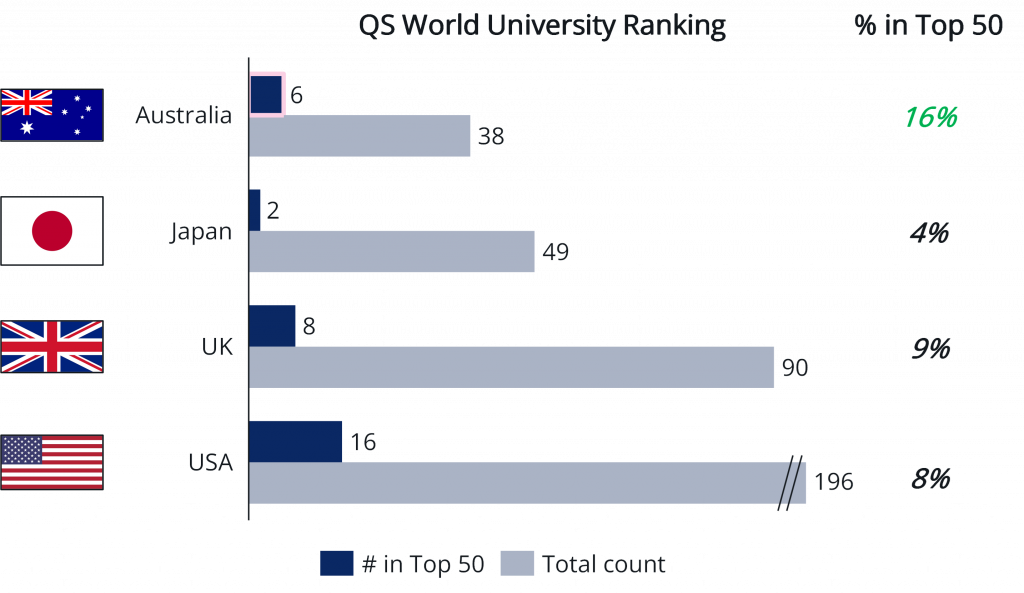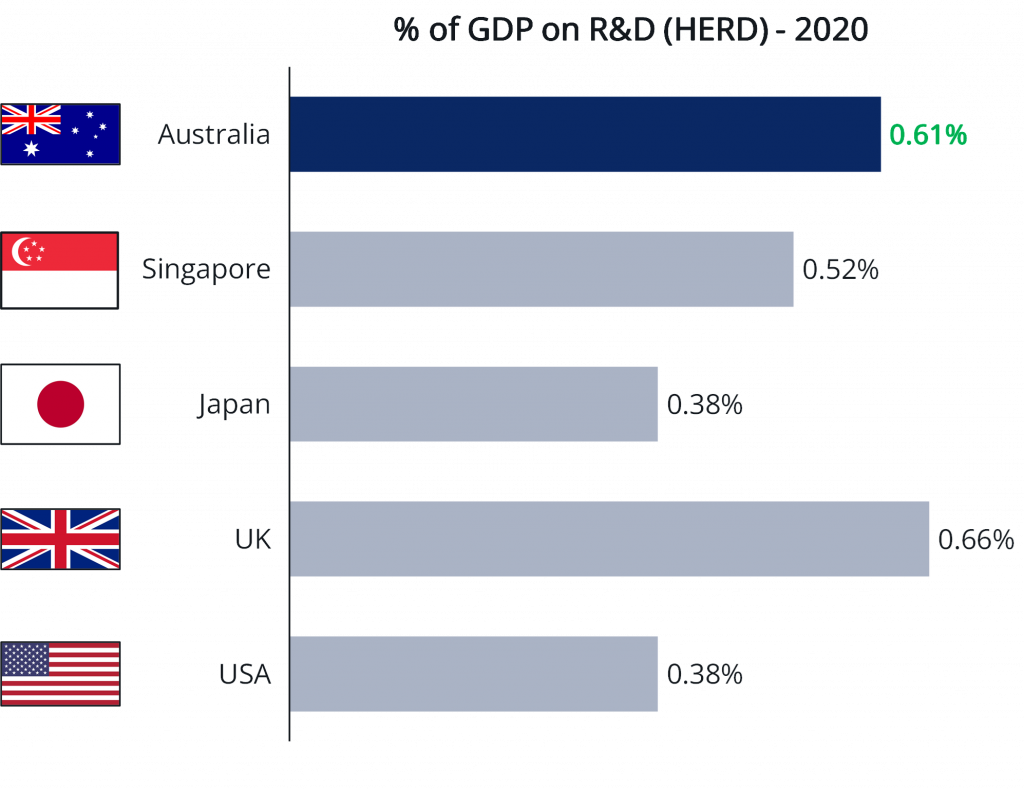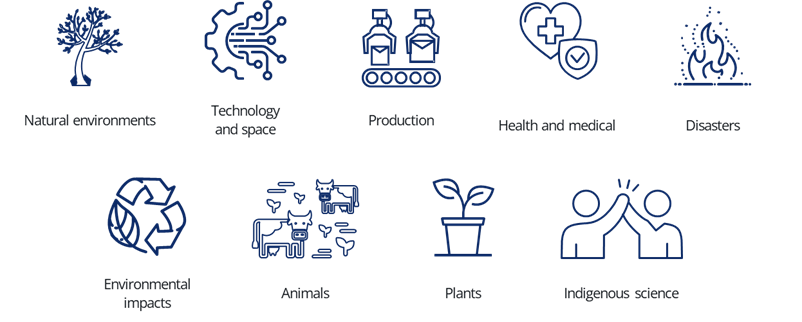



Australia has rich innovation capabilities and potential that could yield significant benefits for Australia-Japan (A-J) innovation and even beyond.
The key question is “How to enable Australia?”
This entails fully unlocking the innovation capability and potential that Australia holds. This article intends to put a spotlight on the rich capabilities and the missing link which Australia as a nation faces to spearhead their innovation efforts for Japan in particular.
The wider objective of this piece is to contribute to discussions on increasing successful A-J innovation cases within the Australia-Japan corridor. Specifically, IGPI shares some of its observations of the potential bottlenecks faced by the Australian side – these include challenges in gaining awareness and recognition from the Japanese side in a customized fashion, which by no means have easy fixes.
Australia-Japan relationship has been a longstanding and complementary relationship that started in the form of trading in traditional sectors such as energy, agriculture, and mining.
It was touched upon in part I how this relationship is now evolving in terms of “What” and “Who” in recent years. Examples touched upon were Japan transitioning from traditional fossil fuels to initiatives such as renewable energy generation and hydrogen; and widening the collaboration partners beyond mega corporations to include universities and startups in Australia. It also highlighted the bottlenecks Japanese corporations face, such as “Why Australia?” and their motivation to explore such opportunities, particularly addressing the alignment or misalignment between the HQ and local arm.
For the full article on part I: What are the bottlenecks being experienced on the Japanese side?
However, this does not mean there are no bottlenecks on the Australian side. Australia faces its own bottlenecks as the “Innovation supplier”, providing solutions to the Japanese “demand” side.
For decades, Australia has been a key partner for Japan. As previously discussed in part I, this relationship has now dramatically shifted towards sourcing innovative solutions in various forms from broader players in the Australian innovation ecosystem. Namely, these have been from (i) Startups / Spinoffs, (ii) Universities, and (iii) Research Institutes.
2.1. Startups and Spinoffs
Throughout the world, startups have played a pivotal role in driving innovation.
Australia, recognized as having one of the largest startup ecosystems in the world (9th in the world, 2nd in Asia-Pacific)1, is home to numerous unicorns such as Canva, Atlassian, and Airwallex, to name a few. But most recently, the B2B sector startups have been on the radar of Japanese corporations, showing notable progress in Japan and beyond:
| Collaboration | Brief Example |
|---|---|
| Macnica x icetana | Macnica has secured a strategic stake in icetana, a leading artificial intelligence software developer. As part of this deal, Macnica will assume the role of the exclusive distributor for icetana in the Japanese and Brazilian markets2. |
| JR East Water Business x Hivery | JR East Water Business in collaboration with Hivery, an Australian AI-driven retail tech company, will roll out AI-driven vending machine optimization solutions to 6,000 vending machines across the East Japan Railway’s train stations3. |
Both examples illustrate Japanese corporations leveraging solutions from Australian startups in Japan and beyond.
One unique fact to note is that both icetana and Hivery are startups but started off as spinoffs of an Australian university or a research institute. The term “spinoff” describes a new and separate entity created by the parent entity that holds all or partial shares4. In the context of an Australian university or a research institute, spinoffs are created with the aim to boost entrepreneurial activities to commercialize a certain innovative technology5. In the same line, icetana was spun off from Curtin University (Perth, Western Australia), and Hivery from the Commonwealth Scientific and Industrial Research Organization (in short CSIRO, Australia’s National scientific research agency).
As these startups and spinoffs aim to commercialize the innovative technology they possess, they represent the significant potential for collaboration with industry partners in technical, business, or financial forms to realize new business opportunities.
2.2. Universities
On the other hand, Australia is a rich source of innovation from numerous universities. Australian universities are recognized for their world-class capabilities, comparable to the institutions the USA and UK universities. Based on QS World University Rankings 2025, the composition for Australia, Japan, the UK, and the USA in total count and the count in the “Top 50s” are as follows:

Figure 1: QS World University Rankings 20256
Factually, Australia ranks 3rd in the Top 50 coverage, behind the USA and UK. The interesting fact here is that despite being 3rd, Australia has the highest “coverage ratio” relative to the country’s total university count within the ranking (6 in the top 50 out of a total 38 = 16%; compared to 8% for the USA and 9% for the UK). This highlights the exceptional quality of Australian universities despite being fewer in number.
This excellence is evident in the “International Research Network” metric introduced by the QS World University Ranking in 2024, which provides insights on how internationally connected an institution’s research is as well as recognizing the importance of collaborative research more broadly7.
Here’s how the top 3 Australian universities fare against their counterparts in the USA and UK in terms of international research connectivity:
| Country | International Research Network Score (Top 3 Average) | University | Individual Score | Overall Rank |
|---|---|---|---|---|
| Australia | 97.2 | The University of Melbourne | 97.4 | 13 |
| The University of Sydney | 95.8 | 18 | ||
| The University of New South Wales | 98.3 | 19 | ||
| USA | 97.5 | MIT | 96 | 1 |
| Harvard University | 99.6 | 4 | ||
| Stanford University | 96.8 | 6 | ||
| UK | 98.9 | Imperial College London | 97.4 | 2 |
| University of Oxford | 100 | 3 | ||
| University of Cambridge | 99.3 | 5 |
Figure 1: QS World UnivTable 1: QS World University Rankings International Research Network Scores8
Again, despite the overall ranking being lower, the research capabilities of the top 3 Australian universities are on par with, or even exceed, those of the leading institutions in the USA and UK. It should be noted that overall ranking includes metrics outside of research capabilities, such as international student ratio, and non-capability specifics.
In addition, Australian university’s research and development spending is notably high on a global scale. This is illustrated by the “HERD” or “Higher Education Expenditure on R&D” metric, which measures the R&D expenditure by higher education entities such as universities as a percentage of GDP. Below is a comparison of the USA, UK, Japan and Singapore:

Figure 2: OECD Stat Dataset – Main Science and Technology Indicators Higher-Education Expenditure on R&D as a percentage of GDP9
| Country | 2016 | 2017 | 2018 | 2019 | 2020 |
|---|---|---|---|---|---|
| Australia | 0.62% | 0.61%* | 0.62% | 0.64%* | 0.61% |
| Singapore | 0.64% | 0.56% | 0.52% | 0.52% | 0.52% |
| Japan | 0.38% | 0.38% | 0.37% | 0.38% | 0.38% |
| UK | 0.39% | 0.39% | 0.65% | 0.63% | 0.66% |
| USA | 0.36%* | 0.37%* | 0.36%* | 0.36%* | 0.38%* |
Table 2: OECD Stat Dataset – Main Science and Technology Indicators Higher-Education Expenditure on R&D as a percentage of GDP10
* Note: Estimate (Australia case) or slight definition differs (USA case), Data based on full available data for all 5 listed country comparison
Apart from the UK, which has increased significantly since 2018, Australia is represented with a consistently high level of expenditure or investment into R&D from a GDP percentage basis, which is by contrast, much higher than the likes of the USA or Japan.
Australian universities offer world-class innovation potential, which can be nurtured as business opportunities. The key importance is to make that “critical step” to collaborate with industry partners to realize that capability outside of the lab and apply it to the real world.
2.3. Research Institutes
Separate from universities, Australia also has numerous research institutes. These can be categorized into individual organizations or “Cooperative Research Centers” (hereafter CRC).
Individual organizations can range from national science agencies such as the CSIRO to more niche specialized research institutes (e.g., Health – Melanoma Institute Australia, or even university spinoff R&D entities, etc.).
Most notably, CSIRO is the largest research institute in Australia and one of the significant globally, is often compared to the Australian version of Japan’s “AIST” (産業技術総合研究所) or “RIKEN” (理化学研究所). Typically budgeted with approximately $1.6B AUD annually, it is ranked as the 6th or 7th against selected international applied research organization over the past 10 years and with over 4,000 industry and government partners11. For reference, AIST’s annual expenditure in FY22 was around $1.1B AUD12**. CSIRO’s R&D ranges in 9 fields (further split into subcategories) and works in a collaborative manner with the universities and industries to bring innovation to the real world13.

Figure 3: CSIRO Research fields14
With its broad coverage and extensive network of connections, CSIRO represents the diverse capabilities of Australia’s national science agency.
The other important research institute category is the CRCs. CRCs are Australian government programs since 1990 with the government providing funding support for industry-led collaborations. CRC themes vary depending on each CRC but are all aimed at addressing industry identified problems and key issues. Typically, CRC are mid to long-term programs that can range from 5 to 10 years, but shorter programs (CRC-P) up to 3 years also exist15. CRCs require at least one Australian industry organization and one Australian research organization, but they are not limited in total numbers, and can include non-Australian corporations as partners as well. Below are examples of CRCs that interacted with Japanese corporations:
| CRC x JP Cos | Focus of CRC | Grant size | Collaboration form |
|---|---|---|---|
| Food Agility CRC x NTT, Yamaha Motor | Support Australian agrifood industry to be profitable and sustainable16 | $50M | Official CRC Partner |
| Future Energy Exports CRC x Impex | Energy export decarbonization17 | $40M | Official CRC Partner |
| Future Energy Exports CRC x JX NOEX, Mitsui O.S. K. Lines, Osaka Gas | Collaboration Conduct research and development to demonstrate the technical feasibility and operability of low-pressure and low temperature solutions for bulk CO2 shipping transport18. | ||
| Heavy Industries Low-carbon Transition (HILT) CRC x Mitsubishi Heavy Industries | De-risk decarbonisation pathways for heavy industry19 | $39M | Official CRC Partner |
Note that entities can be part of the CRC itself (official CRC partner) or engage in a collaborative form, such as the Future Energy Exports CRC with companies like JX NOEX. It is also important to highlight that government grants require the applicants (i.e. CRC lead and partners) to at least match the amount of government grant / funding either through cash and / or in-kind contributions. With both long-term support and commitment, CRCs are unique research initiatives that bring like-minded partners together 20.
While each Australian startup / spinoff, university or research institute faces unique challenges, a common issue is the limited “Awareness” of Australian innovation capabilities. Despite the high quality and rich sources of innovation, Australia’s recognition by Japan lags behind that of global innovation hubs likes of Silicon Valley or Europe.
Unlike the USA or European countries, Japan is a unique country that requires a very different approach culturally or communication wise. Hence from an Australia point of view, applying a global strategy may not necessarily be most effective approach.
IGPI has seen many cases on both the Australian and Japanese sides having basic misunderstandings due to certain cultural differences or communication methods. In particular, the cultural differences can at time cause unnecessary friction unintentionally.
For example, due to the size and organizational structure, Japanese corporations may cause mass communication delays to get to the “Right” person. Even after making contact, an “unwritten” authorization or approval process, known as “Nemawashi”, might be required. This process of consulting stakeholders informally can significantly extend timelines and might be seen as a loss of momentum from a non-Japanese perspective. However, these processes are often integral to Japanese culture, intended to show respect and give courtesy updates to the people who may be impacted by a certain decision, just that it took a bit of time, which may have been out of their control.
To address this type of barrier, it is important for the Australian side to consider a dedicated and specific Japan strategy. This strategy should focus on deepening engagement and forming partnerships with Japan and Japanese corporates. Elements could include prioritizing capabilities that are particularly relevant to Japan, appointing an internal advocate for Japan-related initiatives, and establishing dedicated channels for promotion and interaction with Japanese entities.
It is important to be clear on the details of “what is requested” and “what can be offered as an exchange” from the Australian side to the Japanese side.
Unless there is a clear ambition and direction set for Japan, it could be difficult for both Australian and Japanese side to understand “what is the aim or goal”.
By addressing these bottlenecks with a targeted approach, Australia-Japan collaboration can improve, leading to more successful innovation partnerships across the Australia-Japan corridor.
IGPI Group has developed a deep-rooted understanding of Japanese Corporations and has been a part of the global expansion and ambitions of many prominent companies across the APAC and beyond. If you are an Australian startup, university or research institute, and believe in the potential of Australia-Japan on the pillars of innovation and keen to enhance your approach to Japan / Japanese corporations, we will be glad to have a confidential conversation. IGPI provides highly customized business advisory to its diverse range of clients, including but not limited to:
To find out more about how IGPI can provide consulting support for businesses, browse through our insight articles or get in contact with us.
1 StartupBlink – Global Startup Ecosystem Ranking
2 icetana – https://www.icetana.ai/investor-updates/global-technology-giant-macnica-takes-strategic-investment-in-icetana
3 Hivery – https://www.csiro.au/en/news/All/Articles/2019/November/hivery-exports-ai-solutions-to-the-world
4 investopedia – https://www.investopedia.com/terms/s/spinoff.asp
5 Taylor & Francis Online – https://www.tandfonline.com/doi/full/10.1080/1331677X.2022.2086148
6 QS World University Rankings 2025 – https://www.topuniversities.com/world-university-rankings
7 QS World University rankings Methodology – https://www.topuniversities.com/qs-world-university-rankings/methodology
8 QS World University Rankings 2025 – https://www.topuniversities.com/world-university-rankings
9 OECD. Stat – https://data-explorer.oecd.org/
10 OECD. Stat – https://data-explorer.oecd.org/
11 CSIRO Annual report FY22-23 – https://www.csiro.au/en/about/Corporate-governance/annual-reports/22-23-annual-report
12 AIST: Employees and Budget – https://www.aist.go.jp/aist_e/about_aist/facts_figures/fact_figures.html
** RBA Exchange rate at $1 AUD = ¥97 JPY as of 12/08/24
13 CSIRO Research – https://www.csiro.au/en/research
14 CSIRO Research – https://www.csiro.au/en/research
15 Business.gov.au – https://business.gov.au/grants-and-programs/cooperative-research-centres-crc-grants
16 Food Agility CRC – https://www.foodagility.com/about
17 Future Energy Exports CRC – https://www.fenex.org.au/about/
18 Future Energy Exports CRC news – https://www.fenex.org.au/australian-japanese-partners-execute-rd-project-agreement-to-develop-safe-and-efficient-solutions-for-industrial-scale-shipping-of-co2/
19 HILT CRC – https://hiltcrc.com.au/about/
20 Business.gov.au – https://business.gov.au/grants-and-programs/cooperative-research-centres-crc-grants

Mr. Rachit Khosla is the Country Manager of IGPI Australia. Rachit is a seasoned strategy consulting professional with over 14 years’ experience of leading and executing market entry and growth strategy (both organic and inorganic) and open innovation engagements for Fortune 500 businesses and large MNCs across Asia Pacific. He has advised clients in a diverse range of industries including automotive, fin-tech, industrial and manufacturing, med-tech & healthcare, smart cities, construction materials, travel, IT & telecommunications to name a few. Rachit was the
former Country Manager and Director for YCP Solidiance (Japanese owned) and Founder and CEO of an online B2B marketplace startup for professional advisory services focused on Emerging Markets.

Mr. Kaoru Shingae is a Consultant at IGPI Australia. Prior joining IGPI, Kaoru has worked at Toyota, BMW and Boston Consulting Group, primarily specializing in the Automotive and Mobility sector and with exposure to wider industrial sectors. Kaoru has both internal and external strategy experience with deep understanding on ‘What’ is most important for all stakeholder’s future. He has end-to-end experience from corporate and enterprise level planning to all the way down to the operational planning. Kaoru is a holistic all-rounder in engaging with both strategical and operational stakeholders throughout the company. Past achievements include crisis turnaround plans, long and mid-term vision plans, CEO’s company goal plans and sales & market operational plan plus delivery to name a few. Kaoru has graduated from The University of Melbourne with a Bachelor of Commerce.
Ms. Devina Hashifah is an Intern at IGPI Australia (Nov 2023 – Feb 2024). Devina graduated with a Bachelor of Commerce from the University of Melbourne, majoring in Marketing and Management. She has previously worked in the financial advisory sector and student consulting organizations, conducting research for clients from the agriculture, renewable energy, microfinance, and media industry.
Industrial Growth Platform Inc. (IGPI) is a Japan rooted premium management consulting & investment firm headquartered in Tokyo with offices in Osaka, Singapore, Hanoi, Shanghai & Melbourne. IGPI was established in 2007 by former members of Industrial Revitalization Corporation of Japan (IRCJ), a USD 100 billion sovereign wealth fund focusing on turn-around projects in Japan. IGPI has 13 institutional investors, including Nomura Holdings, SMBC, KDDI, Recruit & Sumitomo Corporation to name a few. IGPI has vast experience of supporting Fortune 500s, Govt. agencies, Universities, SMEs and funded startups across Asia and beyond for their strategic business needs and hands-on support across a wide variety of industries. IGPI group has ~7,500 employees on a consolidated basis.
* This material is intended merely for reference purposes based on our experience and is not intended to be comprehensive and does not constitute as advice. Information contained in this material has been obtained from sources believed to be reliable, but IGPI does not represent or warrant the quality, completeness, and accuracy of such information. All rights reserved by IGPI.